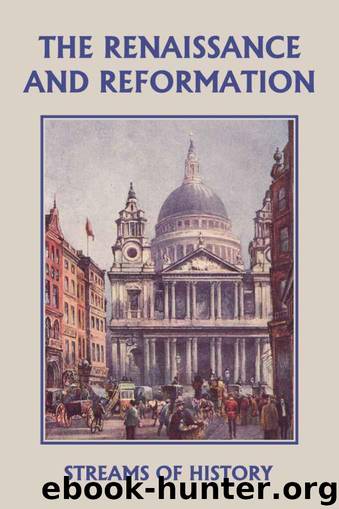Streams of History: The Renaissance and Reformation (Yesterday's Classics) by Kemp Ellwood W

Author:Kemp, Ellwood W. [Kemp, Ellwood W.]
Language: eng
Format: epub
Tags: Juvenile Fiction
ISBN: 9781599152585
Publisher: Yesterday's Classics
Published: 2010-11-10T14:55:01.928000+00:00
How the Reformation Came About, and How It Influenced History in Europe and America
1550–1650 A.D.
THE word Reformation comes from two Latin words, "formare," meaning to form, and "re," again. Thus the word means to form again. Now we wish to see what was formed again, or made over, and where it was done, and when.
You have already seen how the Renaissance, woke up southern Europe from her slumber, and set the scholars hunting up old books and writing new ones; and how, before the Renaissance, the Crusades brought new life to commerce, and made Europe and Asia, join hands by means of great trade routes which extended from one end of the Mediterranean to the other. Now, just as broader ideas were coming to the minds of men in trade and learning, so also were many persons getting finer and fresher ideas about religion; and these new ideas led to new life in the Christian Church, or Catholic Church, as it was then called, since its ideal was to spread Christianity over the entire world.
The period when the idea of reforming the Church took hold of the people so deeply that they talked and struggled for it more than for any other one thing was the sixteenth century; that is, the century just following the discovery of America. But we must keep our minds free from thinking that the Reformation sprang up all at once, as a mushroom springs up, so to speak, during the night. Instead of this, everything which helped to open the minds of people to new thought for four or five centuries before the sixteenth was a step which led, either directly or indirectly, to the Reformation. Let us very briefly review these steps and see how they lead to this one common point.
First, during the twelfth and thirteenth centuries came the Crusades; and these two hundred years of travel between Europe and Asia wonderfully opened the eyes and minds of the travelers, as travel generally does; then came, as a result of acquaintance with the lands around the Mediterranean, a passionate love for the old literature—especially for Greek and Latin literature; this began in the fourteenth century, and no manuscript was too musty, or dim, or too hard to read, to keep the scholars from cleaning the dust off of it and reading it; thus the springs of Greek and Roman thought began to flow again and refresh the minds of western Europe; then, right in the middle of the Renascence movement (1453), the barbaric Turks, in moving westward from Asia, conquered Constantinople, which had been for a thousand years the storehouse of much of the old Greek writing. This drove the scholars westward, but as they went they carried with them their precious manuscripts as a miser would his gold; thus was Europe further enriched by what the old times had to teach, and thousands of scholars began to study the history, the literature, the philosophy and the art of old Greece and Rome;
Download
This site does not store any files on its server. We only index and link to content provided by other sites. Please contact the content providers to delete copyright contents if any and email us, we'll remove relevant links or contents immediately.
The Mayflower and the Pilgrims' New World by Nathaniel Philbrick(4463)
I'm Still Scared by Tomie dePaola(4350)
Bloody Times by James L. Swanson(4335)
Pocahontas by Joseph Bruchac(4216)
Bomb: The Race to Build--And Steal--The World's Most Dangerous Weapon (Newbery Honor Book) by Steve Sheinkin(3899)
Flesh and Blood So Cheap by Albert Marrin(3803)
An American Plague by Jim Murphy(3737)
Little Author in the Big Woods by Yona Zeldis McDonough(3484)
The Giant and How He Humbugged America by Jim Murphy(3414)
Hello, America by Livia Bitton-Jackson(3127)
The President Has Been Shot!": The Assassination of John F. Kennedy by Swanson James L(3072)
Harry Potter: A History of Magic by British Library(3018)
The Landing of the Pilgrims by James Daugherty(2913)
Gettysburg by Iain C. Martin(2806)
The Extraordinary Suzy Wright by Teri Kanefield(2685)
Ben Franklin's Almanac by Candace Fleming(2497)
The Impossible Rescue by Martin W. Sandler(2311)
Bloody Times: The Funeral of Abraham Lincoln and the Manhunt for Jefferson Davis by James L. Swanson(2087)
Who Was Louis Braille? by Margaret Frith(1956)
